Last Updated on June 21, 2024
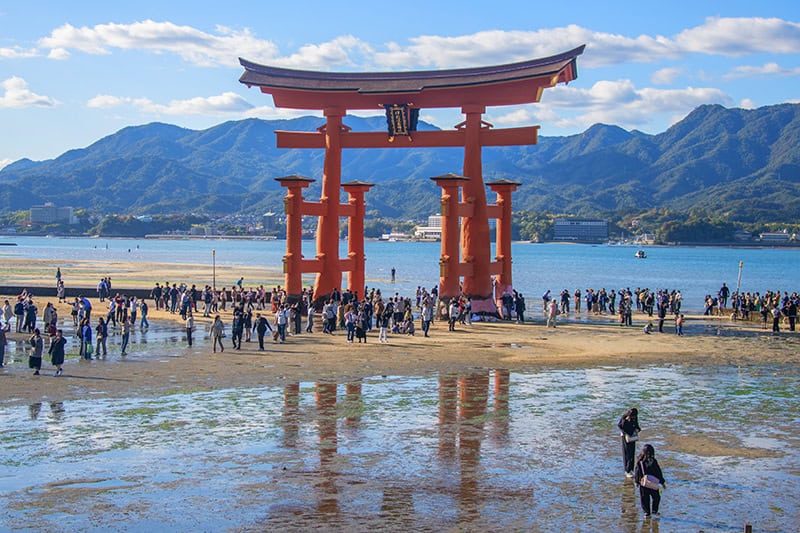
Estimated reading time: 22 minutes
By Jim Ferri and Marjorie Kean
Although I had been to Asia several times, I had been to Japan only a few, and those were years ago. And they were too-quick visits, cobbled together on short stays when flying elsewhere, not allowing me to enjoy the many things to do in Japan. I was looking forward to returning one day.
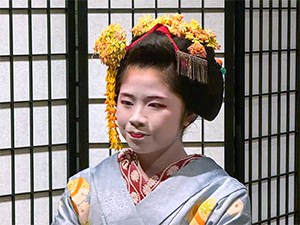
My wife’s Asian experience, on the other hand, was confined to Korea, where she had been in the Peace Corps years ago. But Marjorie always wanted to visit Japan to explore the country and its culture. She felt it would be fascinating to experience and compare the cultures of the two countries. Naturally, both of us believed a Japan visit could be a fascinating trip, in fact, a trip of a lifetime.
Several months ago, we began seriously planning, researching, and comparing tours. After considering several companies offering tours to Japan, we decided on Tauck Tours‘ “Essence of Japan.”
The 10-day “Essence” tour is not inexpensive, but it is upscale and includes things for which other companies charge extra (and it visits several of the most popular places in Japan). Accommodations, for example, are in highly rated hotels such as the five-star Park Hyatt Tokyo. Additionally, whenever possible, we would travel on the famous Shinkansen, Japan’s comfortable bullet train.
But more importantly, it also offered experiences that gave us insight into Japan’s history and culture.
Table of contents
- A Taste of Tokyo
- Welcome to Japan Reception
- The National Museum and a Drumming Class
- A Shrine, A Market
- One of Tokyo’s Oldest Temples
- The Shinkansen
- Hakone Open Air Museum
- Two Museums and A Sushi Class
- Japanese Alps and Views of Fuji
- Matsumoto Castle
- Beautiful Takayama
- A Historic House, An Incredible Garden, Shopping, and a Private Samurai Show
- A Beautiful Island, Shrine, and Great Torii Gate in Japan
- The Hiroshima Peace Memorial Museum and A-Bomb Dome
- Kimonos and Temples, Tea Ceremonies and Geishas, Quiet Lanes and UNESCO Sites
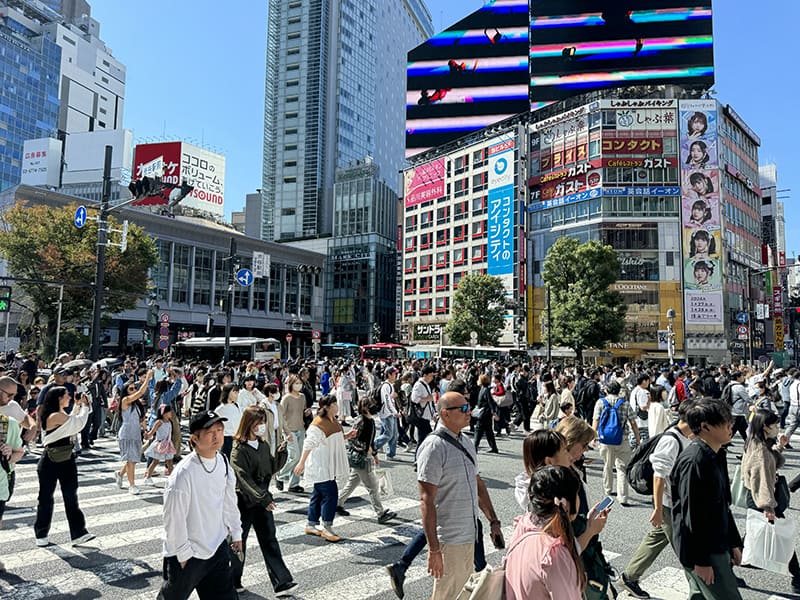
A Taste of Tokyo
We arrived a day early to get acclimated and see a few things not on the Tauck agenda.
One thing we wanted to see was Tokyo’s upscale department stores. Luckily, it was an easy walk from our hotel to the upscale Takashimaya. From my earlier visits, I recall that, like their North American and European counterparts, upscale stores in Japan have expensive clothing, cosmetics, etc., on the upper floors. The lower floor, however, had sushi bars and other food venues, counters filled with imported chocolates, and numerous other foods.

However, I was searching for the unique foods on the lower level that I remembered from those past trips. And I found them once again. These include, among other things, a ¥103,000 ($700) triangular-shaped watermelon), and ¥16,200 ($110) melons each in their individual wooden boxes.
The stores were only an afterthought, however. What we wanted to see most was Shibuya Crossing. In front of Tokyo’s Shibuya Station, it is the busiest pedestrian crossing in the world. It’s a huge intersection where all vehicles stop simultaneously, allowing an incredible number of people to cross at the same time. Various studies estimate that 300,000 – 500,000 people cross during a busy day. Although it wasn’t a busy time or day, we watched in amazement as huge crowds inundated the intersection every two minutes.
Visit Tokyo and you’ll quickly realize it’s a city that can feel both weird and wonderful at the same time.
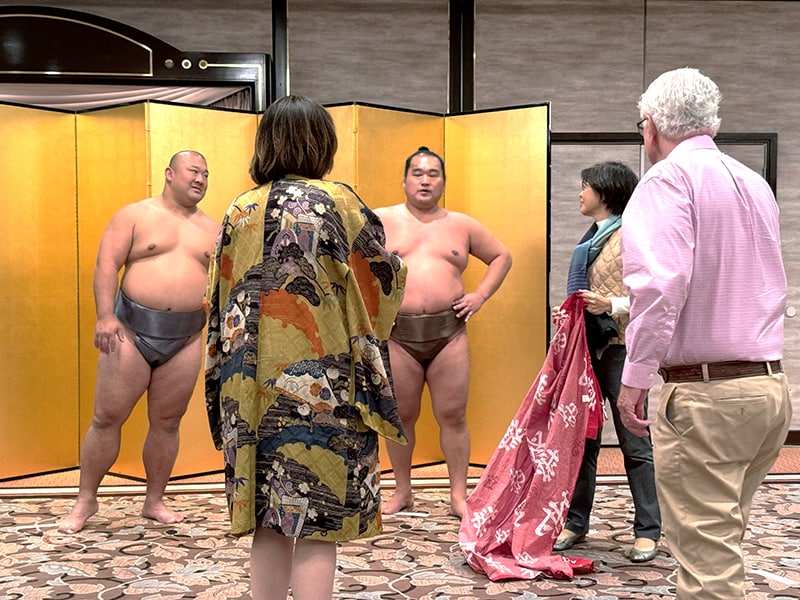
Welcome to Japan Reception
We had a welcome reception/dinner at the historically significant Meiji Kinenkan Hall the first evening in Japan. This dining and reception hall, dating back to 1881, is well-suited for large groups.
Tauck is renown for providing unique tour experiences that set it apart from the competition. True to form, our dinner that night was followed by a table-side exhibition by two professional sumo wrestlers (average weight 330 lb /150 kg), complete with a photo-op.
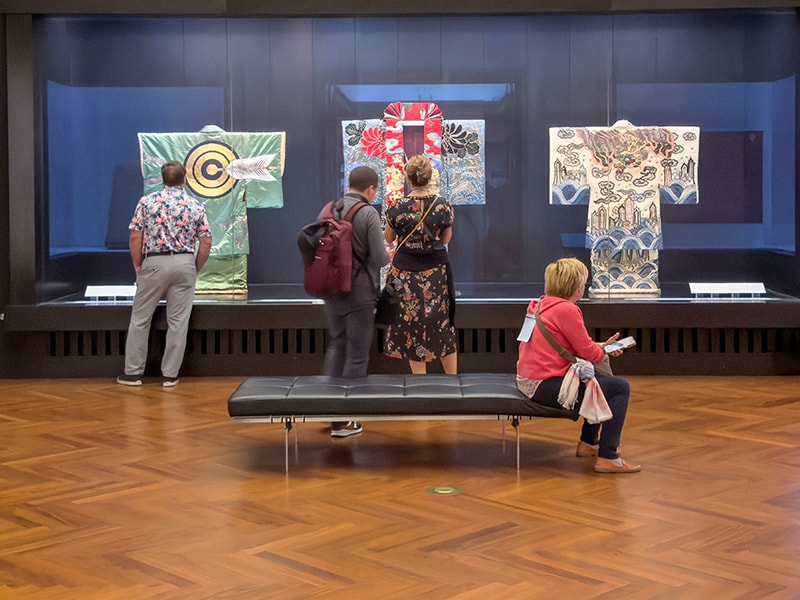
The National Museum and a Drumming Class
The following morning, breakfast was a Western-style buffet, with Japanese breakfasts available to those who reserved the day before. Following the meal, we boarded our coach and set off for the Tokyo National Museum in Ueno Park. The oldest museum in Japan is an incredible place with a collection of more than 100,000 items, about 4,000 of which are on display at any one time.
Although the collection is spread through seven buildings, most visitors only have time to focus on the main building. That alone, however, provides a fascinating peek into Japanese culture and history from the ancient to the modern. Whether you’re on a guided or self-guided tour, the museum is a don’t miss.
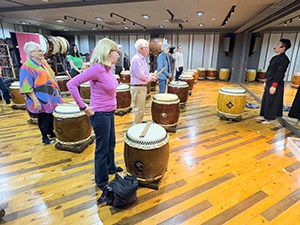
Following the museum, we had a Bento-box lunch at Nobu, a well-known Japanese restaurant, before setting off to the Taiko drum studio. Taiko drums are wooden, barrel-shaped instruments that symbolize Japanese percussion’s powerful rhythm and dynamic energy.
They’re an ancient art that dates back to 10,000 BC and was used in Japan for religious ceremonies and military battles.
Our visit, however, wasn’t just a learning experience but also an experiential one. After learning about Taiko drumming, we were able to experience it for ourselves as our drum teacher led us through various exercises. It was an exciting experience, although the cacophony of two dozen Taiko drums in a room was nearly overwhelming. Nevertheless, the exercise was certainly tension-relieving.
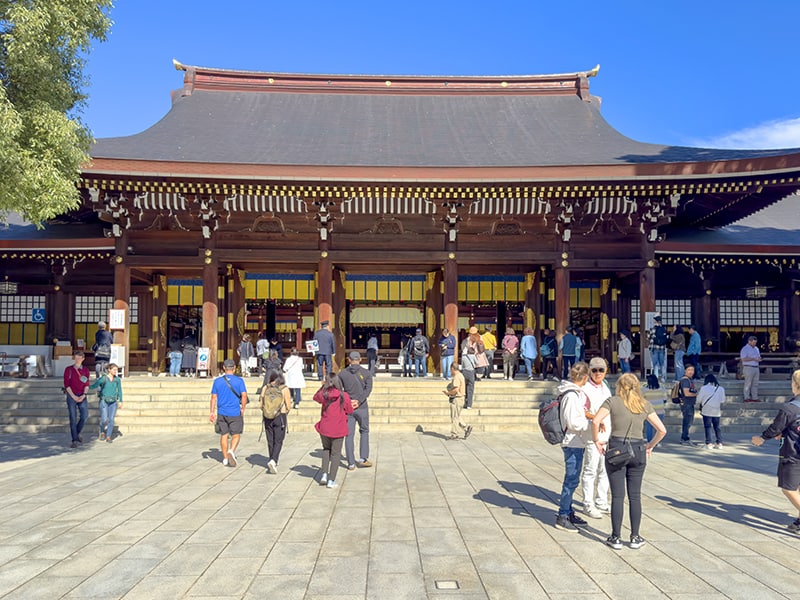
A Shrine, A Market
The following day, we visited Tokyo’s Meiji Shrine. Our visit was preceded by a request from Tauck that we wear culturally appropriate clothing (“no shorts, mini-skirts, or tank tops, please”).
The wooden Shrine is dedicated to Emperor Meiji, who ascended to the throne in 1868 at the age of 14. Meiji is responsible for the modernization of Japan, among other things.
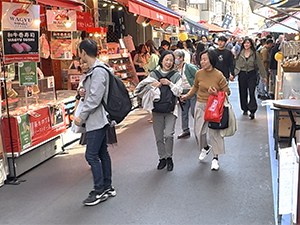
For Tokyoites today, the park – its 170 acres (70 hectares) are planted with 120,000 trees – is a respite from the crowded city. In its Treasure Museum, which, unfortunately, we didn’t visit, are items related to the Japanese Imperial family, including kimonos, furniture, etc.
Following our visit to the Shrine, we boarded our bus to visit the Tsukiji Outer Fish Market. The famous old Tsukiji Fish Market, where the famous tuna auctions were held daily, moved to a more modern facility in Tokyo years ago.
However, hundreds of vendors remained in the crowded old marketplace, transforming it into a central city food market. The vast number and variety of shops spread over a relatively large area were quite interesting. Foodies will likely enjoy it.
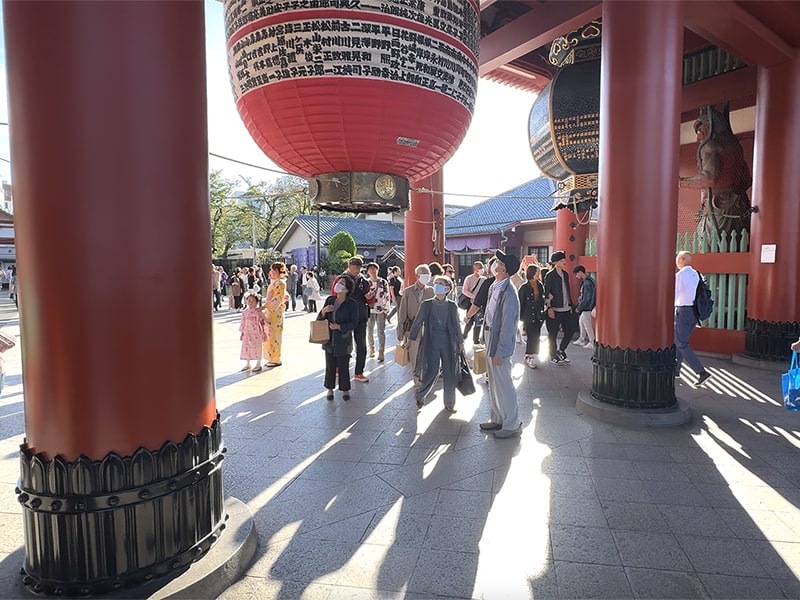
One of Tokyo’s Oldest Temples
Our day ended with a guided visit to Senso-Ji Temple in Asakusa, which retains the feel of old Tokyo. Senso-Ji is an ancient Buddhist temple, one of the city’s oldest. It’s also one of the most significant and most spectacular, considered by some to be the premier destination in Tokyo.
In Japan, Senso-Ji is an important religious center that draws 30 million worshipers every year. I found the rituals performed by many of them equally impressive as the temple. At one fountain, I watched arriving worshipers fill wooden ladles with water to purify their hands and mouths. I also joined a group at a crowded temple doorway, watching a ritual inside. It was colorful, and the crowd was respectful, which is what one would expect.
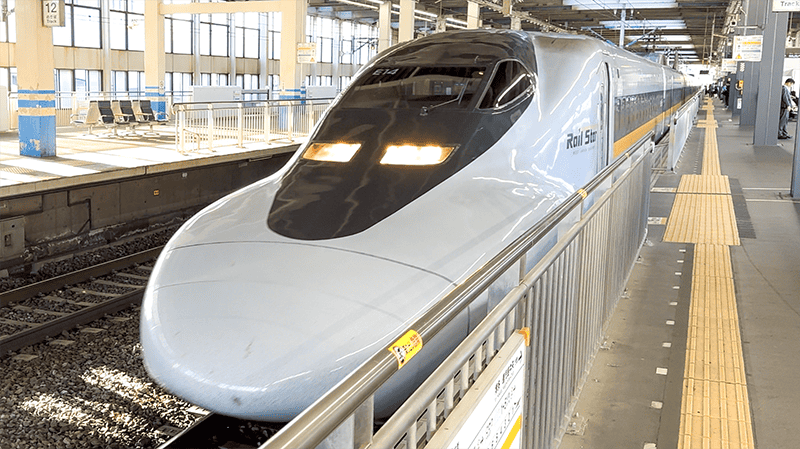
The Shinkansen
The following day, we took our first ride on the Shinkansen (bullet train). Many of us, if not all, had been looking forward to the experience, wondering what to expect.
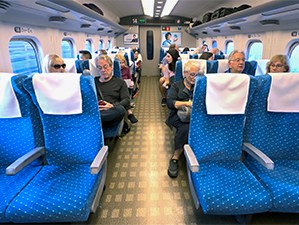
One of the things we did expect, however, was a large, crowded train station; those expectations were quickly realized. On the other hand, the Japanese are very orderly and line up to enter trains, so as we followed our tour guides, we were on the train relatively quickly.
The 200mph ride on the Shinkansen was quite comfortable and exceptionally quiet. In fact, you heard no sounds at all. Because in Japan, one is always considerate of the community; on trains, people only speak in whispers, and cell phones are forbidden. Something else that helps one along is that signs are in Japanese and English and note upcoming stations as well as which side of the train doors will open.
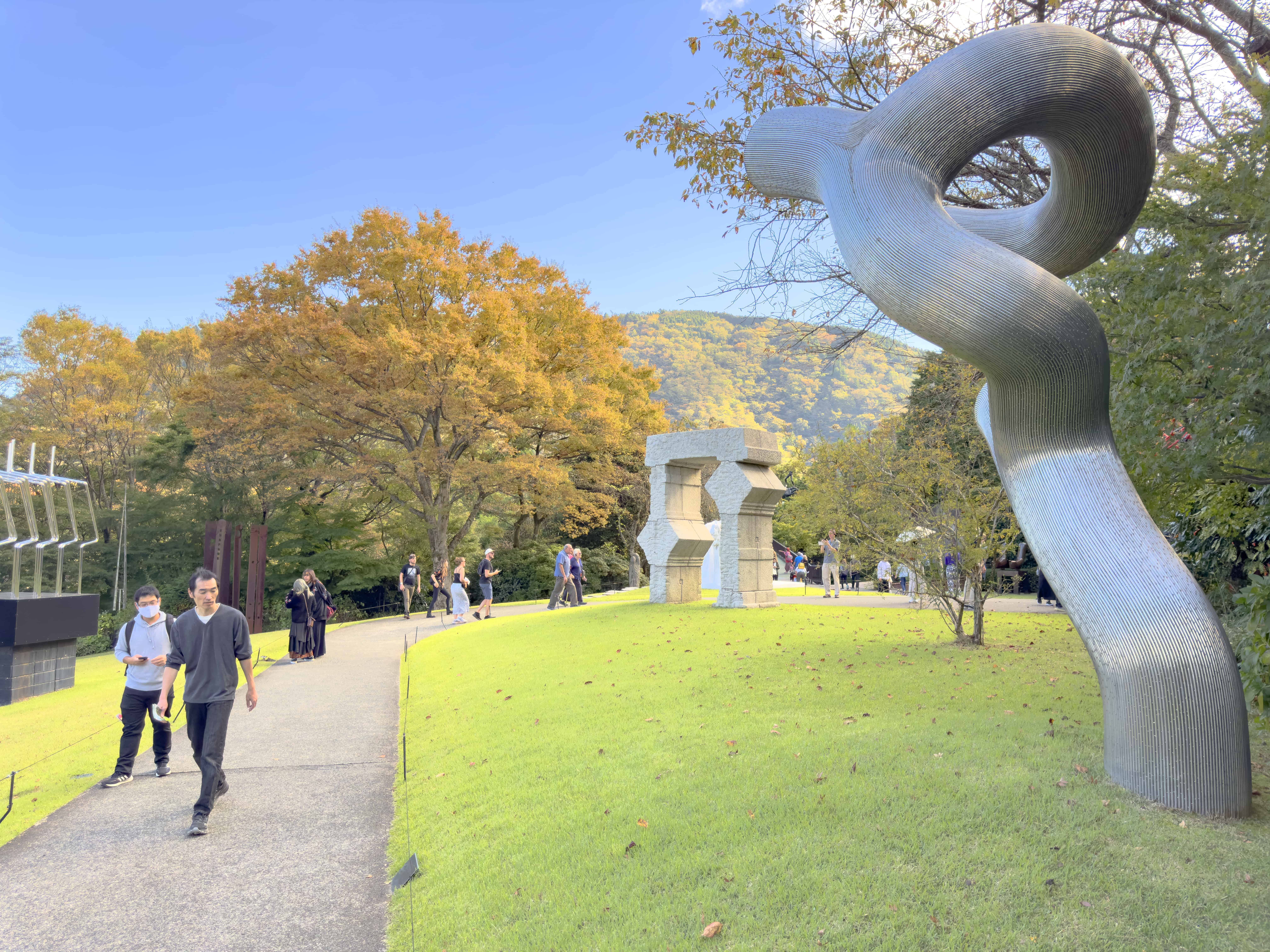
Hakone Open Air Museum
Our bus was awaiting us at Hakone station, and we soon set off for a drive to scenic Lake Ashi. We took a short cruise on the picturesque lake, followed by a lakeside grill buffet.
After lunch, we were off to the Hakone Open Air Museum, Japan’s first open-air museum. It is spectacular, featuring an outdoor sculpture park and some indoor exhibits. It is home to 100 masterpieces by Rodin, Bourdelle, Miro, and Moore and 300 works by Pablo Picasso. The art is exceptional, as is the setting and how the pieces are displayed. Each turn on a path holds a new surprise. It’s another don’t miss if you’re in the neighborhood.
After leaving the museum, we rode to our hotel, the Hyatt Hakone, for about a half-hour. There, we were invited to join another optional Tauck cultural experience: a class on the art of Japanese flower arranging.
Further increasing our cultural immersion, we were asked to wear our yukata (kimonos) to dinner that evening. (Although such requests by Tauck are optional, most in our group complied.) Kimono-clad or not, we enjoyed pre-dinner appetizers and sushi in the hotel’s library.
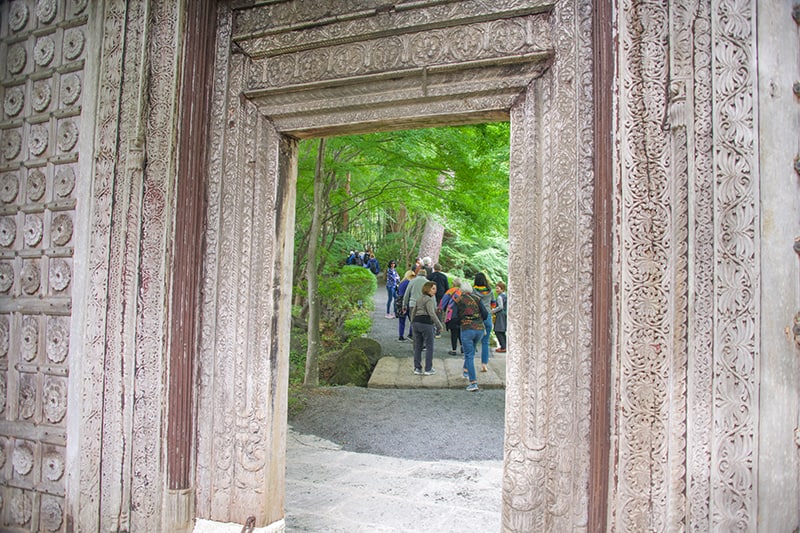
Two Museums and A Sushi Class
The following day, we departed the Hyatt at 8:30 for a 1 ½-hour drive to the Itchiku Kubota Kimono Museum. To tell you the truth, I was not excited about seeing a kimono museum. However, spending half an hour in this museum quickly changed my perspective.
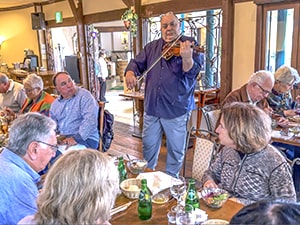
Itchiku Kubota is one of the most important Japanese textile artists of the 20th century. He is famous for reviving and reinventing the lost 15th—16th-century textile dye technique of Tsujigahana silk dyeing. The method was used from the early 14th to the late 16th centuries to decorate elaborate kimono in Japan.
This alone did not excite me…until I saw the results of Kubota’s work. They were exquisite kimonos, elaborately dyed and unlike anything I had ever seen. You need to see them for yourself.
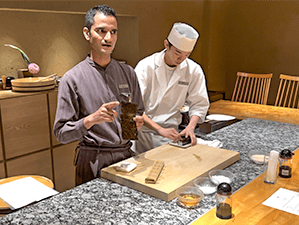
Following our visit, we drove to the Hakone Venetian Glass Museum, stopping for lunch at an adjacent Italian restaurant, Cafe Terrazza. The food was surprisingly good (as was the serenade by the owner playing his violin).
The Glass Museum, however, left much to be desired. However, I may be jaded since I’ve been to several glass exhibits in other museums.
Later that afternoon, after returning to our hotel, the Hakone Hyatt, we enjoyed a Sushi-making demonstration followed by Happy Hour.
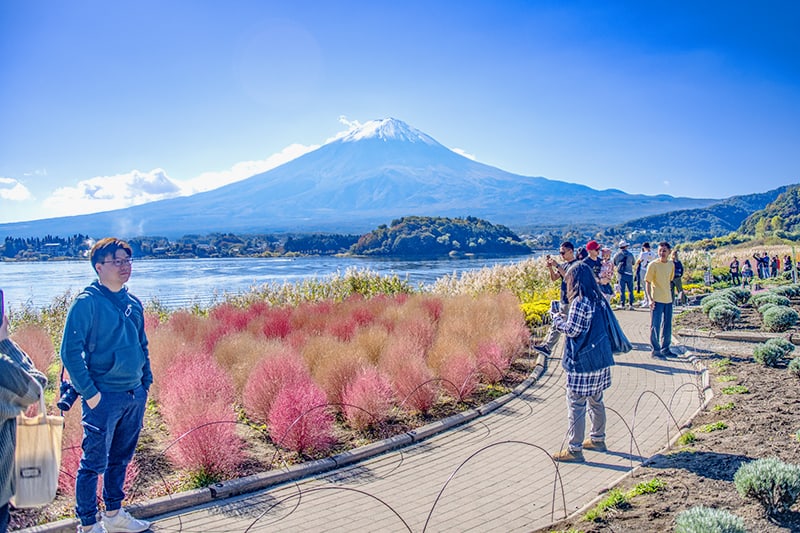
Japanese Alps and Views of Fuji
On day 6, we set off in the morning to drive north through the “Japanese Alps.” It was a beautiful ride through a countryside of rice patties, farms, lakes, and rivers. Along the way, we stopped at Oishi Park on Lake Kawaguchi for some beautiful views of Mount Fuji.
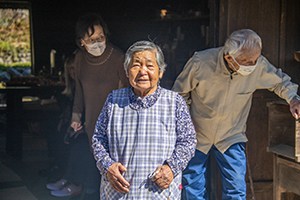
After a half hour, we were back on the bus en route to our destination, the farming village of Ashigawa.
Ashigawa is a small Japanese village where many houses are abandoned, with only a dozen still occupied. Our hosts were a man in his 90s and his wife. We spent a pleasant half-hour in their home, learning about the village and their way of life. Unfortunately, they believe their way of life will disappear in a few years since younger generations are moving to the cities.
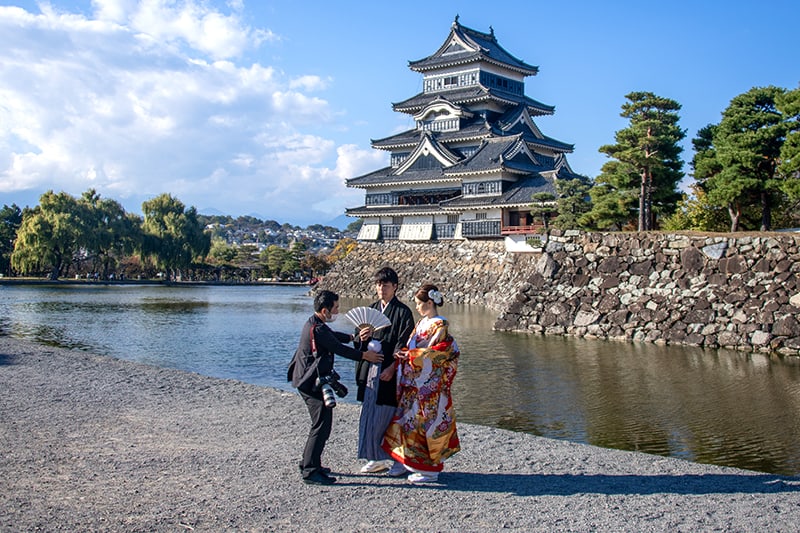
Matsumoto Castle
We were soon back on the bus, on our way to lunch in Matsumoto, the gateway city to “the Alps.” Our afternoon destination is Matsumoto Castle, whose construction began in 1504. It’s the oldest five-tiered castle in Japan and one of only five castles designated as “National Treasures of Japan.”
Many in our group opted to tour the small castle. But since the tour involves many stairs, Marjorie and I decided to walk around the beautiful grounds instead. We soon encountered others from our group who had made the same decision.
Our lodging that night was at Tobira Onsen Ryokan, a historic ryokan built in 705. It’s a beautiful hotel/inn in the mountains with large, very comfortable rooms and beautiful views of the mountains. Although traditional ryokan rooms were available, we opted for a Western-style room.
We removed our shoes and left them at the front door when we entered the hotel. We then donned slippers for our entire stay and collected our shoes when departing. Wherever we were in Japan, especially in temples and other historic places, we abided by the local culture, which required the removal of our shoes. They were always left in a designated place and replaced with sandals provided, with never any fear of them being taken.
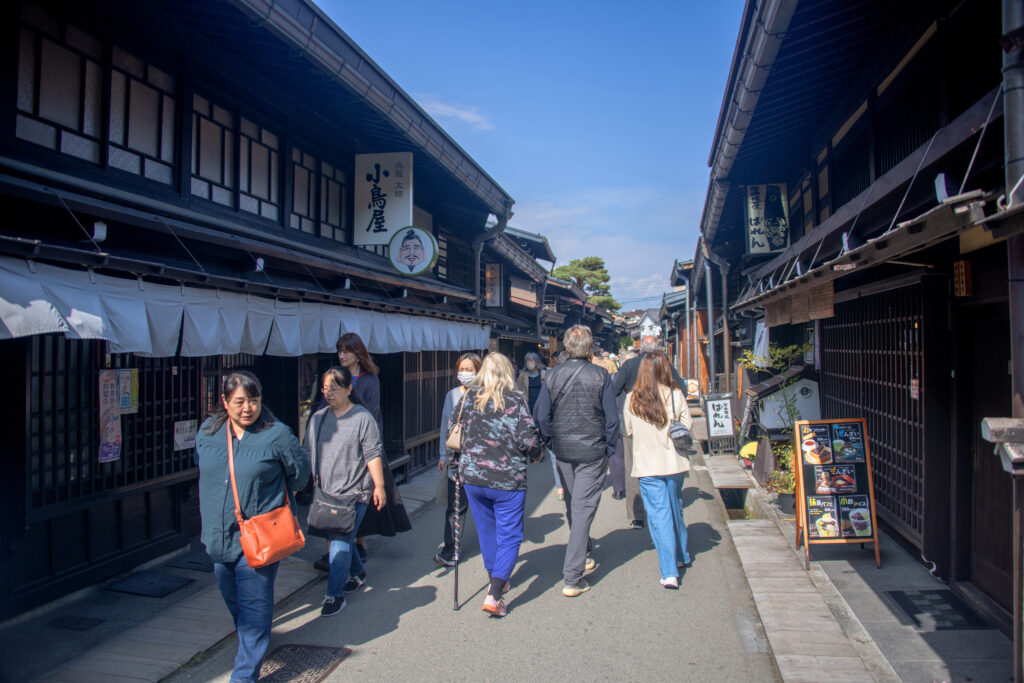
Beautiful Takayama
Our morning was spent touring the charming historic town of Takayama, renowned in Japan for its wooden buildings and charming streets. Many buildings are from Japan’s Edo period (1603 – 1868) and have survived because of the city’s mountain location.
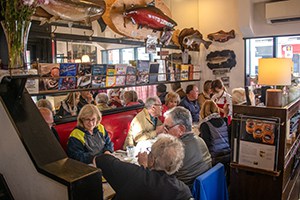
Since Takayama is also renowned for Saké, a Japanese rice wine, we visited one of the city’s six breweries before lunch to learn more about it.
We later had a delicious lunch at Le Midi, a restaurant listed in the Michelin Guide Japan.The experience, however, was more like that in a crowded Parisian bistro than in a Japanese restaurant.
I left the restaurant early to see as much of the city as possible before we moved on later in the afternoon. I wandered aimlessly, admiring the narrow pedestrian streets, each only about 15 feet wide, and their ancient buildings. Groups of schoolgirls in their school jumpers were everywhere, many waving to foreign visitors.
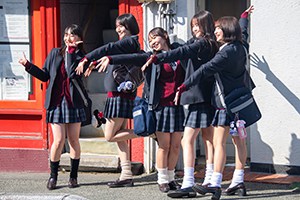
I often saw little walk-up food shops where one ordered through the window. Passing one long line of several dozen people, I walked to the front and found they were waiting for takeaway sushi.
Around the old city, I encountered several rickshaws that offered rickshaw street tours. The cost of a tour was approximately 15 minutes: ¥ 4,000 ($27) / 30 min: ¥ 7,000 ($48) / 60 min: ¥ 14,000 ($95). (Interestingly, I learned the word “rickshaw” is derived from a Japanese word meaning “human-powered vehicle” and was first used in 19th-century Japan).
Late afternoon, we continued to Kanazawa, a short distance inland from the Sea of Japan.
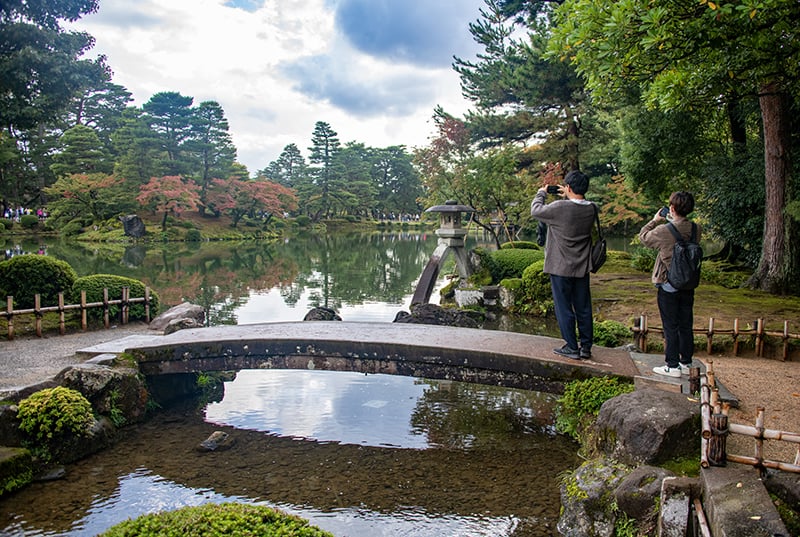
A Historic House, An Incredible Garden, Shopping, and a Private Samurai Show
The following morning, we left our hotel, the Nikko Hotel in Kanazawa, for a full day of touring. First on the list was a visit to a Nomura Samurai House in the Nagamachi area. This residence dates to feudal times when the samurai were prosperous. We found it all quite fascinating.
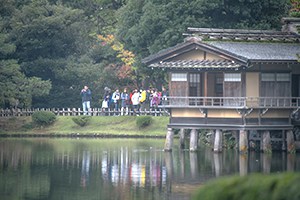
That afternoon, we were off to Kenroku-en Garden, one of Japan’s “great three gardens.” It is the former outer garden of nearby Kanazawa Castle, once the home of the provincial rulers. They constructed the garden over 200 years.
Known as a “strolling-style Japanese landscape garden,” it certainly lives up to its reputation. It’s a beautiful, spacious park that never seems crowded despite the crowds it attracts.
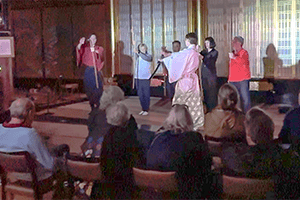
Following lunch at Paul Bocuse, part of the chain of the acclaimed French chef, we strolled through the famous Ohmicho Market. A busy market near Kanazawa Station, it’s a colorful network of covered streets with about 200 shops and stalls. It’s an excellent place to find unusual gifts.
That afternoon, we had a private Samurai show, during which four members of our group were instructed in swordplay using wooden poles. Although the music and modern movements were artistically pleasing, it was more of a dance than actual swordplay.
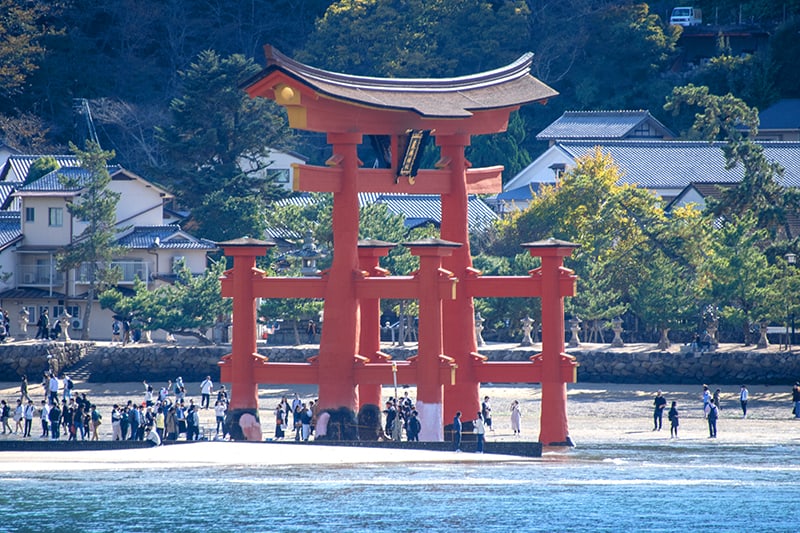
A Beautiful Island, Shrine, and Great Torii Gate in Japan
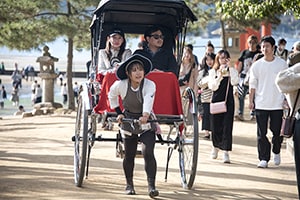
In the morning, we took the train from Kanazawa to Hiroshima. But instead of going to our Hiroshima hotel, we first went to the harbor to take the ferry to Miyajima Island.
Miyajima Island famous in Japan for its 12th-century Itsukushima Shrine and giant, vermilion-colored Great Torii Gate. The gate, partially submerged at high tide, marks the entrance to the Shrine.
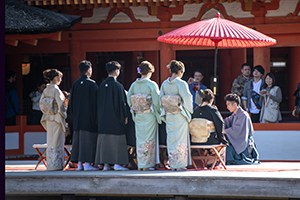
It’s a famous UNESCO World Heritage site, acclaimed to be one of Japan’s three most scenic views. Deer wander freely here, as in other places in Japan, such as Nara.
Above all, Miyajima is considered a sacred island, so much so that neither births nor burials are permitted on it. It is also renowned for its virgin forest, which remains since felling trees is prohibited.
This is one of the great places to visit in Japan and a must-see if you’re ever in Hiroshima.
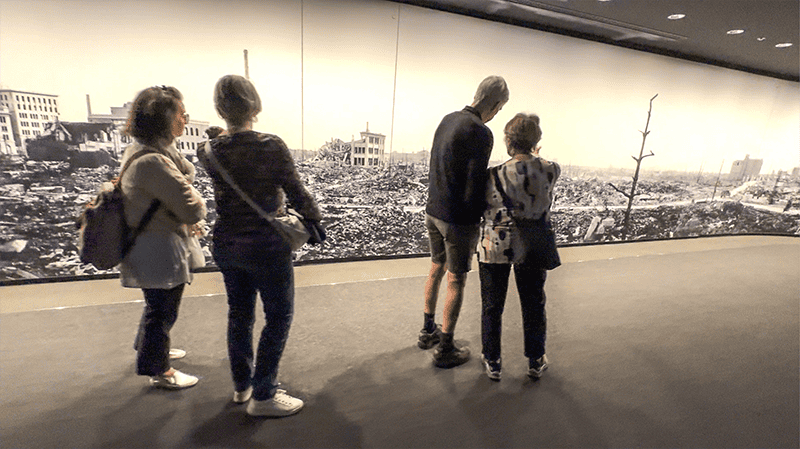
The Hiroshima Peace Memorial Museum and A-Bomb Dome
We were all looking forward to our Hiroshima visit, and in the morning, we set off from the Sheraton Grand. Our tour would take us to the famous A-Bomb dome, Orizuru Tower, and the Peace Memorial Museum.
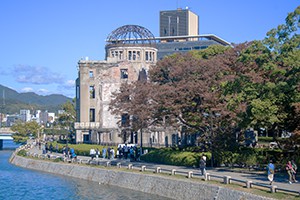
You can’t help but notice the famous A-Bomb Dome, a twisted shell of a dome and building that still stands tombstone-like, reminding the world of that horrific day in 1945.
You can also get a good view of the city and the dome from the observation deck of Orizuru Tower.
However, the most worthwhile place to visit is the nearby Hiroshima Peace Memorial Museum in Peace Memorial Park. It’s like no other museum in the world, offering a balanced and humane outlook on the devastation wrought on Hiroshima.
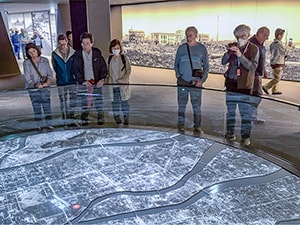
The bombing’s results are explored through original photography, artists’ impressions, items recovered, etc. One entire wall shows a large swath of the city after the bombing.
On the other hand, while the museum explores the horror wrought on Hiroshima, it also doesn’t shy away from Japan’s own violent history. In fact, an entire section of the museum is dedicated to Japan’s bloody campaign in Asia. There are other area’s worth exploring, as well.
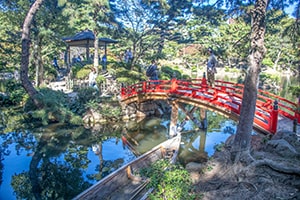
The museum and everything in the surrounding area –– the dome, the curved Cenotaph, and the Children’s Peace Monument –– is a must-see for anyone who visits the city.
After lunch at Zona Italia in Centro, we spent an hour or so visiting Shukkeien Garden . Close to the railroad station, the garden is an excellent place to while away an hour or so before going to Hiroshima station for the bullet train to Kyoto.
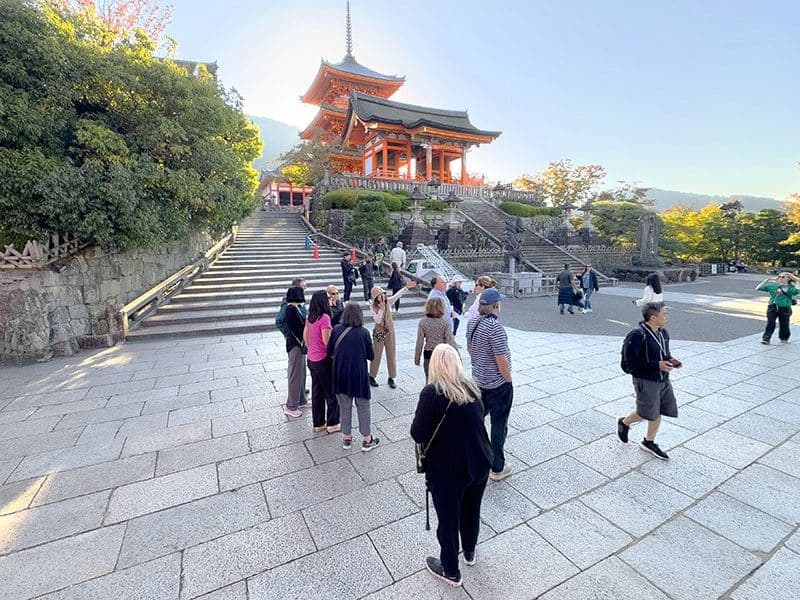
Kimonos and Temples, Tea Ceremonies and Geishas, Quiet Lanes and UNESCO Sites
If Tokyo is modern Japan, Kyoto is its cultural heart. In fact, Kyoto has an incredible 17 UNESCO World Heritage Sites.
To put that in perspective, Tokyo has 2, London 4, and Paris 5.
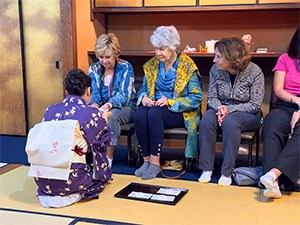
On our Tauck tour in Kyoto, we visited many of these sites. We also immersed ourselves in Japan’s unique culture through a tea ceremony, a sushi preparation event, and an event with geisha.
While in Kyoto, we stayed at the luxurious, modern Park Hyatt Hotel, a spectacular place that amazed us all. Pieced together from several different buildings and houses, it was spacious and beautiful.
Its location, in one of Kyoto’s old neighborhoods, puts it over the top. That’s important because Kyoto’s old neighborhoods are the bastion of ancient Japanese culture.
To read more about our tour experience in Kyoto, click here. We also share the best time to visit Kyoto.

I ‘m really enjoying your discovery of Japan. I look forward to exploring Kyoto in the next section. While you and Marjorie were in Japan, I enjoyed walking your sweet dog Morgen, and during our walks we wondered how your trip was going – now we know! Coincidentally, my sister and her husband are currently in Japan on a month-long visit, and one of my brothers is taking his family to Japan next month – and they are all gaining much insight by reading your articles. Thank you for the tours.
Thanks Greg. We’re glad we were able to help provide insight to so many! And Morgan sends a big lick!